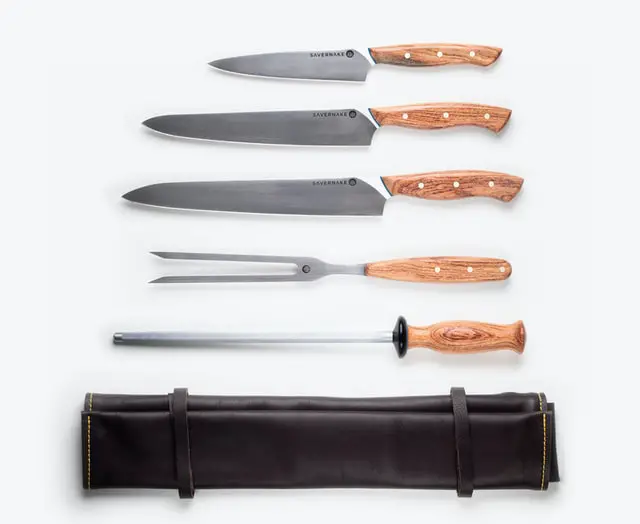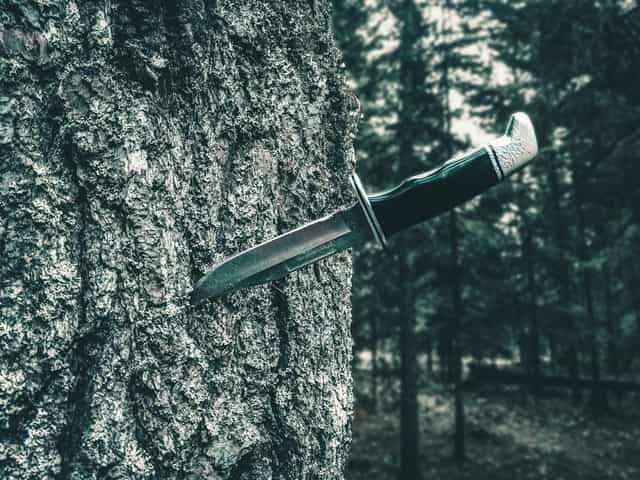So, word on the streets is that you are having some issues with storing your knives properly.
If that’s true, and you have been reading this blog for a while now, that’s my fault and I apologize. If this is your first time here, well, I can’t say I am as responsible. Ha-ha.
For some others, storage is not an issue but proper maintenance can be a hassle.
It’s no shame if you need help on both storage and maintenance fronts either.
You know I don’t judge. Rather, I’ll take you by hand to see some of the best knife storage and maintenance practices to employ today.
PS Have you read my guide to the best knife safety tips to keep yourself, co-workers, loved ones, and everyone around you safer?
The Ultimate Guide to Proper Knife Storage

Let’s start with keeping the knives away in the first place.
Here are some tips to make sure you do that the right way.
- Use magnetic wall strips. They make your kitchen knives a beauty to look at, especially when you have multiple. They also add to the décor and appeal of your kitchen. The good news is that they do not cost an arm and a leg – like this highly recommended pick on Amazon.
- Put your knives in a drawer after use. It is best if you use a top drawer (not an overhead drawer, please) for your knives. Before placing the knives in, spread a towel underneath so that the knives don’t move around when the drawer is opened.
- Get a great knife block. Where magnetic strips are great for their contactless storing methods, they might not be safe for kids. If your knife set did not come with a block, pick up this McCook knife block that sharpens your knives when you put them back in. Sounds cool, right?
- Get a separate sheath for each knife in your kitchen. Sheaths are a little more labor-intensive when you could just stick them on the magnetic strip or put it back into the knife block. However, that does not make them a bad choice at all. I was surprised to find out good ones like this 8-Piece Universal Edge Guard don’t even cost much.
- Leather knife rolls are also a great way to store your kitchen knives. They are stylish, functional, and contain dedicated cut-outs for each kind of knife. The quality of leather also makes it impossible to get cut by the knife from the outside of the leather knife roll. Take a look at this 10-Piece, Travel-Friendly Knife Roll Bag and you’ll see what I’m saying.
- How about in-drawer knife blocks? I have talked about storing your knives in a drawer, and also what knife blocks hold for you. Most knife blocks are so huge that they have to be placed on the kitchen countertop, though. How about a knife block that was designed to sit in your drawer, like the Eco-friendly Bamboo in-drawer block? That keeps your knife out of sight and makes the kitchen safer for kids. Especially if you keep the drawer locked too.
- I don’t like this method as much (or even at all), but it’s not my choice to make. That’s overhead counter storage. I don’t like putting knives where everyone can’t see what they’re getting out. Everyone in the household won’t be at the same height. The last thing I want is for someone to take one knife while another one comes rappelling down at them. If you can manage this kind of storage mode, though, you could go for it.
- Sometimes, bag them. This is not for everyone. If you are a chef who gets on the road with their knives, or you’re traveling and have to take your knives with you, get a knife bag like this one.
These Knife Maintenance Tips Makes all the Difference

I’m not even kidding.
You can’t go through this list of knife maintenance techniques and not have a better, longer-lasting knife collection as a result.
I’ve been told that I talk too much. Let’s get into the matter for the day
- Your knife should always be kept dry and clean. Even when you cut something that doesn’t look like it would stain the knife, clean it!
- Again, your knife should be dried off after washing. This is one of the best ways to prevent rust, among other things.
- Speaking of washing the knife, never put your knife in a dishwasher. All washing should be done exclusively by hand.
- Some suggest using warm soapy water to wash your knives. I cannot always turn the heater on or warm some water just to wash a knife. I have used water at room temperature and normal dishwashing liquid with much success.
- Never leave the knife to soak in water. Besides this contributing to rust on the blade, it also weakens the handle and rivets – depending on the knife handle material.
- Always store your knives properly. Refer to any of the pointers above for the best results
- Properly clean and wipe down carbon steel knives whenever you take them to acidic foods (citrus, tomatoes, berries, tomatoes, etc). These food items attack the coating on carbon steel knives and could ruin them faster.
- Oil your knives after washing them. For knives that you use frequently, I don’t see the need in oiling them. If you would be storing a knife away for longer, though, get a food-safe oil and apply small amounts to the blade. This also helps prevent rust.
- Sharpen your knives when they start to feel dull. Follow this comprehensive knife sharpening guide to do it yourself at home, or seek out a professional.
- Hone your knives more than you sharpen them. Sometimes, honing is the only thing the knife needs. Look at this guide to honing and sharpening to know what both do for you.
- Don’t forget to strop your knives properly after sharpening. Besides getting it sharper with aligned edges, it also eliminates burrs on the surface of the blade.
- Stay off machine sharpening. They are best suited to industrial blades, not kitchen knives. Most of them are too abrasive anyway and will just end up ruining your knives.
- Don’t test the sharpness of your knife on poor items that could ruin the blade. Try these multiple knife sharpness testing methods for a change.
- When sharpening your knives, know the kind of whetstone you need. They might look the same when shopping online, but they are different. Look at the different grit levels – and when you need them – here.
- Do not use hard dish soap or detergents to wash your knives.
- If your knives are rusting, use these tips to remove the rust and keep the knife from later rust.
- Protect your carbon steel knives better by wiping them down after each use, rather than running them under water all the time. Due to the higher concentration of carbon here, these knives are more susceptible to corrosion. This way, you can prevent that from happening.
- Not every knife should air dry. You can leave your stainless steel and ceramic knives to air dry, but never your carbon steel kitchen knives.
- Use a cutting board with your knife. Plastic is great – and I have found this eco-friendly set of bamboo cutting boards that are great for different food items. These cutting boards prevent the edge of your knife from coming into contact with hard surfaces (like your kitchen countertop), which causes the blade to go dull.
- Learn proper cutting techniques. You might not know this, but the up-and-down cutting motion that most of us are used to is dulling our knives faster than we know. Try the proper rocking and sliding cutting motions. They provide cleaner cuts anyway.
Wrapping it Up
Not to brag, but you just powered through twenty-eight (28) of the most concise, straightforward, and useful knife care and maintenance tips out there.
With that, I feel like my work here is done.
If there is anything I missed, or you’ve got any questions at all, you could use the comments section. You’re welcome to tell me how awesome this list is too.






![What Is A Paring Knife Used For? [Uses, Best Brands & FAQs]](https://cutsandcarves.com/wp-content/uploads/2021/05/What-Is-A-Paring-Knife-Used-For-Uses-Best-Brands-FAQs-768x1024.jpg)

